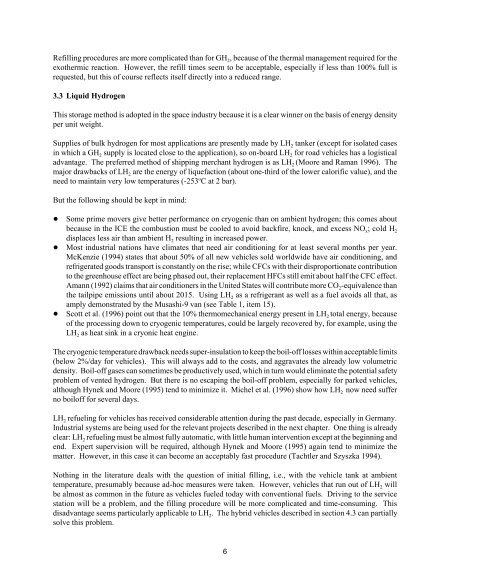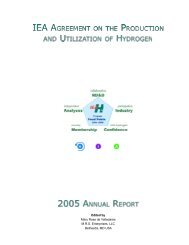Technology Status of Hydrogen Road Vehicles
Technology Status of Hydrogen Road Vehicles
Technology Status of Hydrogen Road Vehicles
You also want an ePaper? Increase the reach of your titles
YUMPU automatically turns print PDFs into web optimized ePapers that Google loves.
Refilling procedures are more complicated than for GH 2, because <strong>of</strong> the thermal management required for the<br />
exothermic reaction. However, the refill times seem to be acceptable, especially if less than 100% full is<br />
requested, but this <strong>of</strong> course reflects itself directly into a reduced range.<br />
3.3 Liquid <strong>Hydrogen</strong><br />
This storage method is adopted in the space industry because it is a clear winner on the basis <strong>of</strong> energy density<br />
per unit weight.<br />
Supplies <strong>of</strong> bulk hydrogen for most applications are presently made by LH 2 tanker (except for isolated cases<br />
in which a GH 2 supply is located close to the application), so on-board LH 2 for road vehicles has a logistical<br />
advantage. The preferred method <strong>of</strong> shipping merchant hydrogen is as LH 2 (Moore and Raman 1996). The<br />
major drawbacks <strong>of</strong> LH 2 are the energy <strong>of</strong> liquefaction (about one-third <strong>of</strong> the lower calorific value), and the<br />
need to maintain very low temperatures (-253 o C at 2 bar).<br />
But the following should be kept in mind:<br />
! Some prime movers give better performance on cryogenic than on ambient hydrogen; this comes about<br />
because in the ICE the combustion must be cooled to avoid backfire, knock, and excess NO x; cold H 2<br />
displaces less air than ambient H 2 resulting in increased power.<br />
! Most industrial nations have climates that need air conditioning for at least several months per year.<br />
McKenzie (1994) states that about 50% <strong>of</strong> all new vehicles sold worldwide have air conditioning, and<br />
refrigerated goods transport is constantly on the rise; while CFCs with their disproportionate contribution<br />
to the greenhouse effect are being phased out, their replacement HFCs still emit about half the CFC effect.<br />
Amann (1992) claims that air conditioners in the United States will contribute more CO 2-equivalence than<br />
the tailpipe emissions until about 2015. Using LH 2 as a refrigerant as well as a fuel avoids all that, as<br />
amply demonstrated by the Musashi-9 van (see Table 1, item 15).<br />
! Scott et al. (1996) point out that the 10% thermomechanical energy present in LH 2 total energy, because<br />
<strong>of</strong> the processing down to cryogenic temperatures, could be largely recovered by, for example, using the<br />
LH 2 as heat sink in a cryonic heat engine.<br />
The cryogenic temperature drawback needs super-insulation to keep the boil-<strong>of</strong>f losses within acceptable limits<br />
(below 2%/day for vehicles). This will always add to the costs, and aggravates the already low volumetric<br />
density. Boil-<strong>of</strong>f gases can sometimes be productively used, which in turn would eliminate the potential safety<br />
problem <strong>of</strong> vented hydrogen. But there is no escaping the boil-<strong>of</strong>f problem, especially for parked vehicles,<br />
although Hynek and Moore (1995) tend to minimize it. Michel et al. (1996) show how LH 2 now need suffer<br />
no boil<strong>of</strong>f for several days.<br />
LH 2 refueling for vehicles has received considerable attention during the past decade, especially in Germany.<br />
Industrial systems are being used for the relevant projects described in the next chapter. One thing is already<br />
clear: LH 2 refueling must be almost fully automatic, with little human intervention except at the beginning and<br />
end. Expert supervision will be required, although Hynek and Moore (1995) again tend to minimize the<br />
matter. However, in this case it can become an acceptably fast procedure (Tachtler and Szyszka 1994).<br />
Nothing in the literature deals with the question <strong>of</strong> initial filling, i.e., with the vehicle tank at ambient<br />
temperature, presumably because ad-hoc measures were taken. However, vehicles that run out <strong>of</strong> LH 2 will<br />
be almost as common in the future as vehicles fueled today with conventional fuels. Driving to the service<br />
station will be a problem, and the filling procedure will be more complicated and time-consuming. This<br />
disadvantage seems particularly applicable to LH 2. The hybrid vehicles described in section 4.3 can partially<br />
solve this problem.<br />
6













